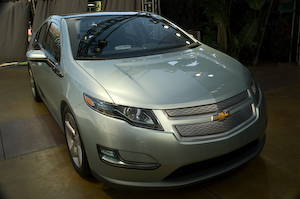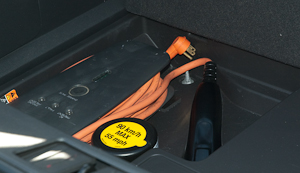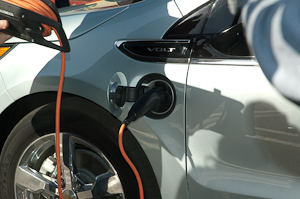![]()
 |
Chevrolet Volt - Charging
|
As mentioned earlier, the Volt can be charged from either 120V or 240V AC using the same charging port on the car. This is a conductive coupling, as opposed to the inductive coupling used by the EV1. The connector is the proposed SAE J1772 standard plug. In theory it is capable of handling 16.8KW / 70 amps, so it was a surprise to us that the Volt can only charge at a 3KW rate at 240V. This is half of what the EV1 and typical house circuit (such as for an electric dryer) can handle. The reasoning might be that the Volt has a smaller battery back to fill, but we feel that it should use up to 6 KW for those times when we might want a quick recharge while having lunch or other short stop at home or a public charger. In fact, when one has a smaller battery back, the tendency is to stop more often for a quick recharge, so charging speed is more important for cars with small battery packs.
|
The 120V charging cord is carried with the car (under the rear cargo compartment floor) and plugs into any standard 3-prong 120V socket. Naturally, the charging rate is slow, but adequate for overnight charging of the Volt's small battery pack. If the circuit is being used for something else while the car is charging, there is a possibility of tripping a breaker, so they have thoughtfully included a button to press which limits the current draw to 8 amps. As we have come to expect in modern EV's, the charging start time can be programmed in the car to take advantage of lower electric rates at night. For safety, the charger port of the car itself implements an intelligent connection which cuts off current and sounds the horn at any sign of an electrical fault. These include disconnection of the cord during charging, or plugging in a cord to a dead circuit. The charging also resumes should power ever fail during charging. This is an important feature which the RAV4 EV and Mini E do not do properly! |
Negatives? Our main complaints are the reduced charging rate (3KW instead of the possible 6KW), and the placement of the charger port near the driver's door. This location seems arbitrarily chosen and we prefer it to be in the middle of the front where it is not biased toward one side of the car, and closest to where one would find a public charger standing if one heads into a parking stall as most people do. The location on the side appears to leave more cord in the way of being stepped on or driven over by an adjacent car. A car pulling out could also rake the side of the car, causing far more damage than just scratched paint.

